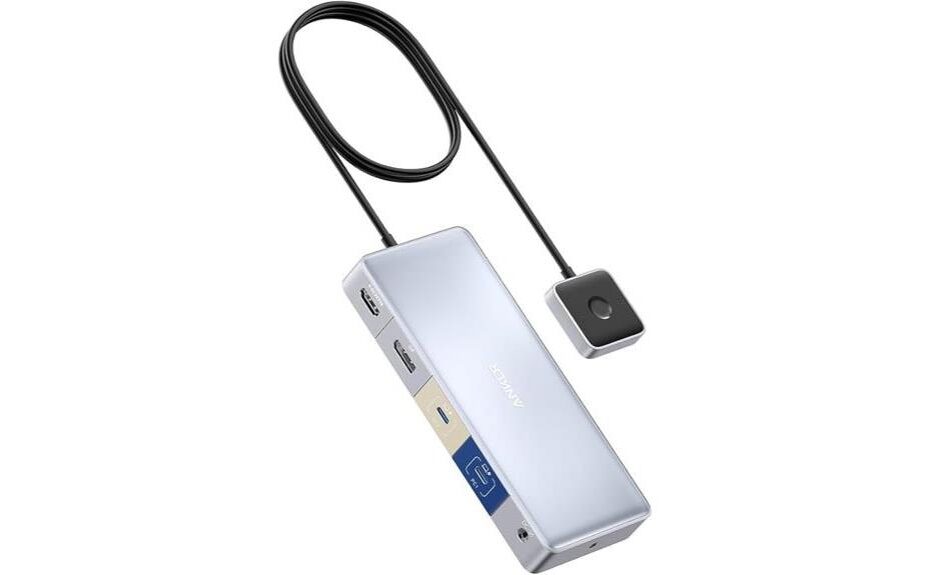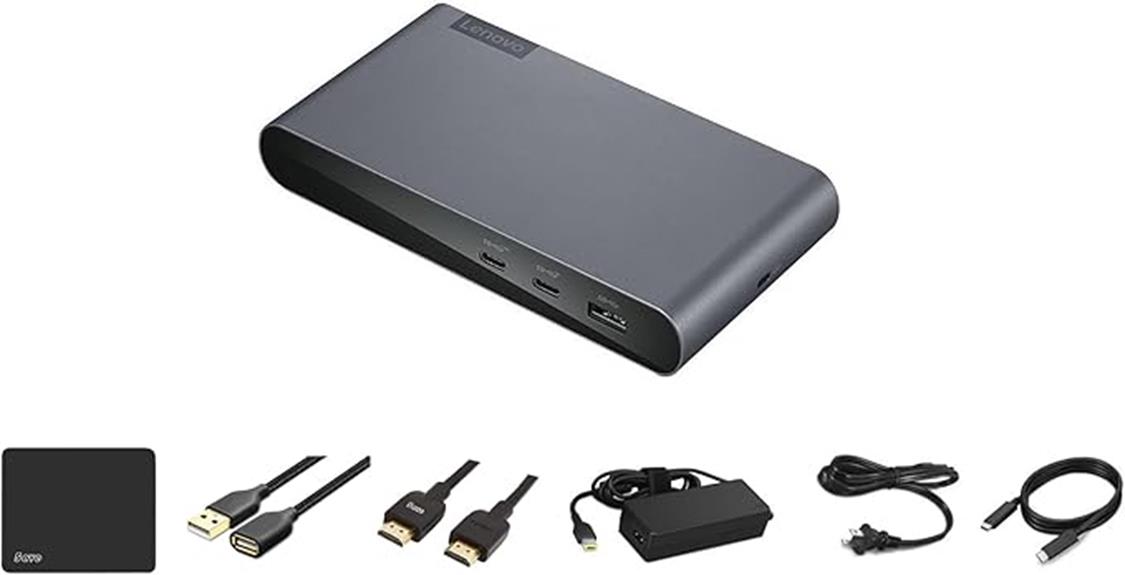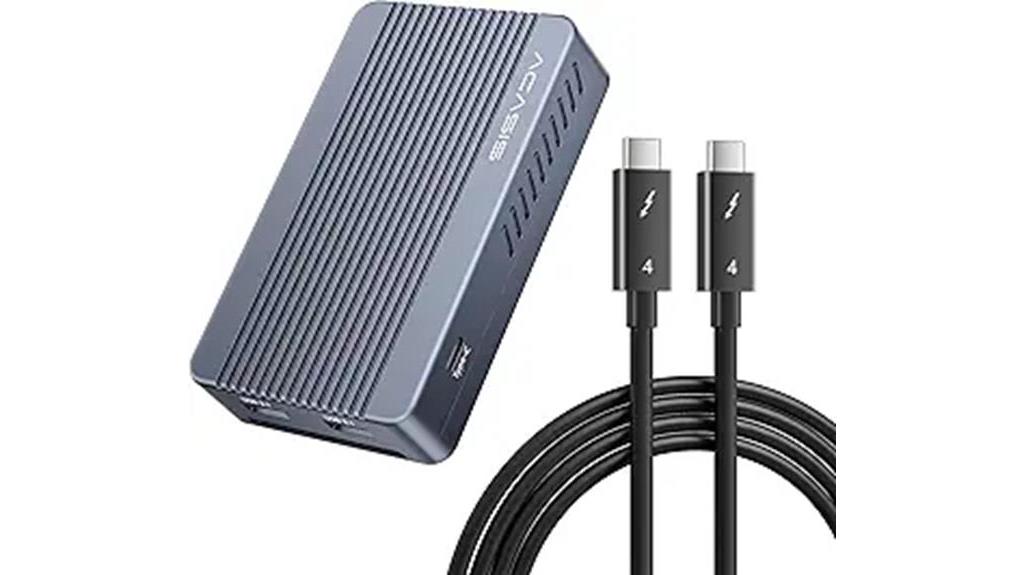



I recently evaluated the Anker Docking Station, particularly its dual 4K performance, and found it quite impressive. Its multiple USB ports and robust power delivery allow seamless multitasking and efficient device management. The switch between laptops happens under five seconds, which minimizes disruption. However, I noticed minor issues like occasional monitor disconnections and some lag during device switching. Despite these drawbacks, it's a valuable tool for remote professionals needing high-quality visuals. Overall, I think it offers decent value for its price. There's definitely more to uncover about its features and how to maximize performance.
Key Takeaways
- The Anker Docking Station supports dual 4K monitor setups, enhancing multitasking and productivity for professionals and gamers alike.
- It features multiple USB ports for versatile connectivity, including three USB-C and two USB-A ports.
- Power Delivery allows for up to 100W charging while using connected devices, streamlining your workspace.
- Users may experience occasional monitor disconnects and switching delays, impacting overall performance.
- The docking station's sleek design and compact size make it ideal for modern workspaces and remote work environments.
When I first got my hands on the Anker Docking Station, I was enthusiastic to see how well it could handle my dual laptop setup. The user experience was immediately noticeable; the sleek design quality of the dock complemented my workspace while providing a functional hub for my devices. It's compact, measuring just 6.69 x 2.83 x 0.94 inches, making it easy to fit on my desk. However, I found the plastic construction to be less robust than I'd hoped. The remote button, while convenient, felt weak and didn't offer the best accessibility. Overall, the Anker Docking Station impressed me with its user-friendly layout and aesthetic appeal, even if some design aspects could use improvement for a more durable feel.
Features and Benefits
The Anker Docking Station offers impressive features that enhance my productivity. With seamless USB-C device switching and the ability to deliver up to 100W of power while I work, it simplifies my setup. Additionally, the multiple video output and USB port options cater to my diverse connectivity needs, making it a valuable addition to my workspace.
Seamless USB-C Device Switching
Seamless USB-C device switching is a standout feature of the Anker Docking Station, enhancing productivity for users juggling multiple laptops. With its robust USB C compatibility, I can effortlessly switch between devices in under five seconds. This feature minimizes downtime, allowing me to focus on my tasks without fumbling around with cables. The docking station supports various laptops, including MacBooks and Lenovo models, ensuring versatility in my workspace. Although it's not instant, the speed is acceptable, making it a practical solution for multitasking. Overall, the seamless device switching capability streamlines my workflow, reduces clutter, and keeps my setup efficient, proving invaluable for anyone managing multiple USB-C devices simultaneously.
Simultaneous 100W Power Delivery
One of the standout features of the Anker Docking Station is its simultaneous 100W Power Delivery, which considerably enhances my productivity. This capability allows me to charge my devices while using them, streamlining my workspace with just one cable connection. The charging efficiency is impressive; I can power my laptop and peripherals without worrying about battery drain. Additionally, the intelligent power management guarantees that every connected device receives ideal power, preventing overloads and maximizing performance. I've noticed a significant reduction in downtime, as I no longer need to juggle multiple chargers. Overall, this feature not only simplifies my setup but also contributes to a more effective workflow, making it an essential aspect of the docking station.
Multiple Video Output Options
With multiple video output options, the Anker Docking Station enhances my ability to manage dual monitor setups effortlessly. It supports various video output formats, including HDMI and DisplayPort, allowing me to connect different types of monitors without hassle. This flexibility means I can easily adapt my workspace, whether I'm using a high-resolution 4K monitor or a standard display. The dock's monitor compatibility extends to popular devices like my MacBook and Lenovo laptop, ensuring that I can utilize dual screens effectively. While some users experience mirrored outputs with Mac, overall, the docking station performs well for multitasking and productivity. The ability to switch between displays seamlessly has truly transformed how I work.
Multiple USB Port Options
While using the Anker Docking Station, I appreciate the variety of USB port options it offers, which considerably enhances my connectivity. With three USB-C Power Delivery ports, two USB-A ports, and one USB 2.0 port, I find it easy to connect multiple devices simultaneously. These USB connectivity options alleviate many peripheral compatibility concerns, allowing me to utilize my keyboard, mouse, and external drives without hassle. Although some users may desire additional ports, the current configuration suffices for most needs. I can seamlessly switch between laptops while maintaining power delivery and data transfer, making it an efficient solution for my workspace. Overall, the variety of ports considerably contributes to the docking station's versatility and usability.
Product Quality
Examining the Anker Docking Station's product quality reveals a blend of functional design and practical performance. The build durability stands out, as the plastic construction feels robust despite its lightweight nature. I appreciate how the dimensions are compact, making it easy to integrate into any workspace without cluttering my desk. The design aesthetics are sleek, aligning well with modern tech setups. However, the remote button, while magnetic, feels a bit flimsy and could benefit from a sturdier design. Overall, the Anker Docking Station combines solid build quality with an appealing appearance, making it a reliable choice for anyone needing a versatile docking solution. Its practicality enhances my user experience without compromising on style.
What It's Used For
I find the Anker Docking Station particularly useful for creating an efficient dual monitor setup, which enhances my productivity. Its ability to switch seamlessly between devices saves me time and effort when working on multiple laptops. Additionally, the power delivery feature simplifies my workspace by charging my devices while I work, reducing clutter from multiple cables.
Dual Monitor Setup
Dual monitor setups are increasingly popular among professionals and gamers alike for their ability to enhance productivity and streamline workflows. I've found that a well-planned monitor arrangement can drastically improve my efficiency. With dual displays, I can run multiple applications simultaneously—keeping my email open on one screen while working on documents or browsing the web on the other. This setup allows for better organization and quicker access to information.
When configuring my display settings, I make certain that each monitor is optimized for its specific use, whether it's for viewing code, editing graphics, or gaming. The ability to easily switch between screens reduces clutter and creates a seamless working environment, making the dual monitor experience invaluable in my daily tasks.
Device Switching Efficiency
Device switching efficiency is essential for anyone juggling multiple laptops or devices. With the Anker Docking Station, I found that the switching latency is generally acceptable, taking under five seconds to switch between computers. While it's not instantaneous, it doesn't greatly hinder my workflow. This efficiency is critical for maintaining a smooth user experience, especially when I'm working on multiple tasks across different machines. The ability to quickly switch guarantees that I can stay focused without unnecessary interruptions. However, some users have reported longer switching times when using USB-C connections, which could affect productivity. Overall, the docking station strikes a good balance between performance and convenience, allowing me to manage my devices effectively.
Power Delivery Benefits
Alongside its efficient device switching, the Anker Docking Station offers impressive power delivery capabilities that enhance its overall functionality. One of the standout features is its charging efficiency, delivering up to 100W PD. This means I can power my laptop while simultaneously using the docking station for multiple peripherals, which simplifies my workspace and reduces cable clutter. The device compatibility is another advantage; it supports a range of devices from Lenovo laptops to MacBooks and iPads. This versatility guarantees that I can connect various gadgets without worrying about compatibility issues. Overall, the power delivery feature not only keeps my devices charged but also optimizes my productivity by allowing seamless integration of my tech ecosystem.
Product Specifications
When evaluating the Anker Docking Station, it's essential to examine its specifications, which highlight its versatility and functionality. The product dimensions of 6.69 x 2.83 x 0.94 inches make it compact enough for most desks, while the lightweight design of 9.9 ounces adds to its portability. The power supply is robust, delivering up to 100W PD, ensuring seamless charging while using multiple devices.
| Specification | Details |
|---|---|
| Product Dimensions | 6.69 x 2.83 x 0.94 inches |
| Weight | 9.9 ounces |
| Power Supply | Up to 100W PD |
These specifications provide a solid foundation for understanding the Anker Docking Station's capabilities and design.
Who Needs This
The Anker Docking Station caters to a variety of users who require efficient management of multiple devices. For remote work professionals like myself, it simplifies the process of connecting laptops to dual 4K monitors and various peripherals, streamlining productivity. When I switch between devices, the seamless change is essential, especially during video calls or presentations. With versatile connectivity options similar to high-end mini PCs, it guarantees that all your peripherals are easily accessible. Tech enthusiasts will also appreciate the multiple USB ports and high power delivery capabilities, allowing for quick charging while using several gadgets simultaneously. This docking station proves invaluable for anyone looking to enhance their workspace, whether you're a digital nomad or a home office warrior. Overall, it's designed for those who demand efficiency and versatility in their tech setup.
Pros
One of the standout advantages of the Anker Docking Station is its user-friendly design, which makes connecting multiple devices a breeze. The thoughtfully integrated design features enhance my overall user experience, simplifying tasks that would otherwise be cumbersome. Here are some key pros I've identified:
- Multiple ports for versatile connectivity
- Dual 4K resolution support for crisp visuals
- Efficient charging capabilities with up to 100W PD
- Quick switching between devices with minimal delay
These design features not only streamline my workspace but also provide a seamless way to manage various devices. I appreciate how easy it is to set up and utilize, making my daily workflow more efficient and organized. Overall, it's a solid investment for anyone needing a reliable docking solution.
Cons
While the Anker Docking Station boasts several advantages, it's important to also consider its drawbacks. Here are some of the main customer concerns I've encountered:
- Missing cables upon purchase
- Monitor disconnects during use
- Long switching times for USB-C devices
- Limited USB ports for peripherals
These product limitations can be frustrating for users who expect seamless functionality. For instance, the occasional monitor disconnect can interrupt workflow, and the prolonged switching time might not meet every user's needs, especially in fast-paced environments. Additionally, the lack of extra USB ports may leave some users scrambling for connections. Overall, understanding these cons helps paint a fuller picture of the Anker Docking Station's performance and usability.
What Customers Are Saying
Many users appreciate the Anker Docking Station for its user-friendly setup and sleek design. In my exploration of customer experiences, I've found that many value the seamless connectivity between multiple devices. User insights often highlight the convenience of charging while using the dock, which simplifies their workspace. However, some feedback indicates frustration with switching times and occasional monitor issues, particularly with Mac setups that sometimes mirror displays instead of extending them. While four USB ports are useful, several users wish for additional options for more peripherals. Overall, the consensus seems to be that while the docking station excels in many areas, there's room for improvement, particularly in switching speed and connectivity stability.
Overall Value
Considering the insights from customers, the overall value of the Anker Docking Station becomes clearer. When I look at the pricing comparison with similar products, Anker's offering stands out, especially with its dual 4K support and multiple connectivity options. While some alternative options may come at a lower price, they often lack the thorough features that Anker provides, such as the seamless USB-C switching and robust power delivery. However, it's essential to highlight the mixed reviews regarding reliability and performance. If I prioritize versatility and performance, the Anker Docking Station justifies its price. Yet, buyers should weigh these factors against their specific needs and consider alternatives that might offer better reliability at a similar or lower cost.
Tips and Tricks For Best Results
To get the most out of your Anker Docking Station, I recommend refining your setup by strategically arranging your devices and connections. First, verify ideal cable management; using cable ties or clips can help prevent clutter and make connections easier to access. This not only enhances aesthetics but also improves airflow, which can benefit device performance.
Next, take advantage of the user customization options available. Adjust display settings on your laptops to verify you're utilizing the full dual 4K capabilities. I've found that tweaking graphics settings can minimize any mirroring issues with Macs. Finally, regularly check for firmware updates to keep your docking station performing at its best. These simple steps can greatly enhance your experience.
Conclusion
Overall, the Anker Docking Station consistently delivers a reliable solution for users needing to connect multiple devices efficiently. My user experience has been largely positive, especially with its seamless switching and dual 4K support. While I noticed some minor issues—like the occasional lag during switching and a few complaints about mirrored displays with Macs—the overall performance meets my expectations. Customer satisfaction seems to be a common theme, as many users appreciate its user-friendly design and effective functionality. However, I do agree that additional USB ports would enhance versatility. Ultimately, the Anker Docking Station is a solid choice for anyone looking to streamline their workspace, balancing performance with practicality.
Frequently Asked Questions
Can I Use the Docking Station With Gaming Consoles?
When I connect my gaming console to the docking station, I notice a stark contrast: seamless gaming performance versus occasional lag. While console connectivity's generally smooth, some users might face minor hiccups in display output.
Does It Support Audio Output Through HDMI or Aux?
Yes, it supports audio output through both HDMI and AUX. I've noticed that the audio quality meets my expectations, adhering to HDMI specifications, ensuring clear sound alongside the visual experience when using the docking station.
What Is the Maximum Power Output for Charging Devices?
The maximum power delivery for charging devices is up to 100W. I find this feature enhances device compatibility greatly, allowing me to power multiple laptops and peripherals efficiently without worrying about running out of battery.
Are There Any Known Compatibility Issues With Specific Laptops?
I've noticed some users report compatibility issues with specific laptop models, particularly when using USB-C connections. It's crucial to check compatibility lists, as not all devices perform seamlessly with certain connection types.
How Does the Warranty Process Work for This Product?
The warranty process involves claiming coverage within 18 months of purchase. I found it straightforward; I just contacted customer service, provided my details, and they quickly addressed my issue, ensuring a smooth resolution.
Disclosure: As an Amazon Associate, I earn from qualifying purchases.




